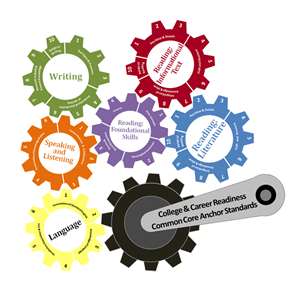| 6.G.1 |
I
can find the area of triangles and quadrilaterals, and use those strategies
to find the area of any polygon. |
•_Shapes
• NavigatingThroughGeometry
|
1. Designing
Bumper Cars
2. Changing Area, Changing Perimeter
3. Measuring Triangles
4. Measuring Parallelograms
5. Measuring Irregular Shapes |
| 6.G.2 |
I
can find the volume of a right rectangular prism with fractional edge
lengths. |
•_Shapes
• NavigatingThroughGeometry |
P
|
| 6.NS.2 |
I
can fluently divide multi-digit numbers. |
•_Numbers |
1. Multi-digit Divisions |
| 6.NS.3 |
I can fluently solve multi-digit decimal problems using all four basic
operations. |
•_Numbers |
1. Decimals More or Less
2. Decimal Times
3. The Decimal Divide
4. Using Percents
5. More About Percents |
| 6.G.4 |
I can represent a 3-D figure using a net and
find the surface area.
|
•5-23VolumeOfSolids
• NavigatingThroughGeometry |
P
|
|
|
| 6.RP.1 |
I can describe and explain a ratio between two
quantities. |
•_Ratios
• MathCore/Fractions |
1. Fundraising
Fractions
2. Sharing
And Comparing with Fractions |
| 6.RP.2 |
I can determine and explain a unit rate in a
given ratio.
|
•Speed Math
• MathCore/Fractions |
1. Fundraising
Fractions
2. Sharing
And Comparing with Fractions |
| 6.RP.3 |
I can use ratio and rate reasoning to solve
real world and mathematical problems.
|
•Speed Math
• MathCore/Fractions |
1. Estimating With Fractions
2. Adding and Subtracting Fractions
3. Multiplying With Fractions
4. Dividing With Fractions |
| 6.NS.1 |
I can divide fractions with like and unlike
denominators. |
•_Fractions
• MathCore/Fractions |
1. Estimating
With Fractions
2. Adding
and Subtracting Fractions
3. Multiplying
With Fractions
4. Dividing With
Fractions |
| 6.NS.4a |
I can determine the GCF of two whole numbers
from 1 to 100. |
•Factoring
• EdHelper/Numbers |
P
|
| 6.NS.4b |
I can determine the LCM of two whole numbers
from 1 to 12. |
•Factoring |
P
|
| 6.NS.4c |
I can use the Distributive Property to express
the sum of two whole numbers from 1 to 100. |
•PropertiesIdentities |
P
|
|
|
| 6.NS.5 |
I can identify positive and negative value of
quantities when given a real-world situation. |
•_Numbers |
P
|
| 6.NS.6 |
I can locate positive and negative rational
numbers on a number line and use it to create a coordinate graph.
|
•_Numbers |
1. Fundraising
Fractions
2. Sharing
And Comparing with Fractions
3. Moving
between Fractions and Decimals
4. Working
With Percents
1. Looking at
Data
2. Using
Graphs To Explore Data
3. What
Do We Mean By Mean |
| 6.NS.7 |
I can order and compare rational numbers and
their absolute values when given a real-world situation.
|
•_Numbers |
1. Fundraising
Fractions
2. Sharing
And Comparing with Fractions |
| 6.NS.8 |
I can apply real-world context to graph points
in all four quadrants of the coordinate graph. |
•_Data |
1. Looking at
Data
2. Using
Graphs To Explore Data
3. What
Do We Mean By Mean |
| 6.EE.1 |
I can write and solve problems using order of
operations.
|
•_Operations
• OpsProps |
1. Order of operations. (PEMDAS) |
| 6.EE.2 |
I can translate and evaluate a relationship
given in words into an algebraic expression. |
• Algebra
• NavigatingThroughAlgebra |
2. Variable Expressions |
| 6.EE.3 |
I can apply the properties of operations to
create equivalent expressions. |
• Algebra
• NavigatingThroughAlgebra |
3. Equivalent Expressions |
| 6.EE.4 |
I can identify and prove when two expressions
are equivalent.
|
• Algebra
• NavigatingThroughAlgebra |
3. Equivalent Expressions |
| 6.G.3 |
I can draw and find the side lengths of polygons
in the coordinate graph when given coordinates for the vertices. |
•_Shapes |
1. Bees and
Polygons
2. Polygons and
Angles
3. Polygon
Properties and Tiling
4. Building
Polygons |
|
|
| 6.EE.5 |
I can explain that solving an equation or
inequality leads to finding the value(s) of the variable that will make
a true mathematical statement by using substitution.
|
•Variables |
P
|
| 6.EE.6 |
I can use a variable to represent a mathematical
or real-world situation. |
•Variables |
2. Variable Expressions |
| 6.EE.7 |
I can use inverse operations to solve one-step
mathematical or real-world problems. |
•_Data |
2. Variable Expressions |
| 6.EE.8 |
I can write an inequality, explain the solution
set, and graph on a number line.
|
•_Data |
P
|
| 6.EE.9 |
I can create a table of two variables that
represent the real-world situation in which one quantity will change in
relation to the other.
|
•_Data |
P
|
|
|
| 6.SP.1 |
I can recognize and write statistical questions
that will include variability. |
•_Data |
1. Looking at
Data
2. Using
Graphs To Explore Data
3. What
Do We Mean By Mean |
| 6.SP.2 |
I can describe a set of data by its center,
spread, and overall shape. |
•_Data |
1. Looking at
Data
2. Using
Graphs To Explore Data
3. What
Do We Mean By Mean |
| 6.SP.3 |
I can represent and explain the difference
between measures of center and measures of variability. |
•_Data |
1. Looking at
Data
2. Using
Graphs To Explore Data
3. What
Do We Mean By Mean |
| 6.SP.4 |
I can display data using a number line, dot
plot, histogram, and box plots. |
•_Data |
1. Looking at
Data
2. Using
Graphs To Explore Data
3. What
Do We Mean By Mean |
| 6.SP.5 |
I can summarize numerical data sets in relation
to their context. |
•_Data |
1. Looking at
Data
2. Using
Graphs To Explore Data
3. What
Do We Mean By Mean |
